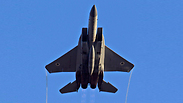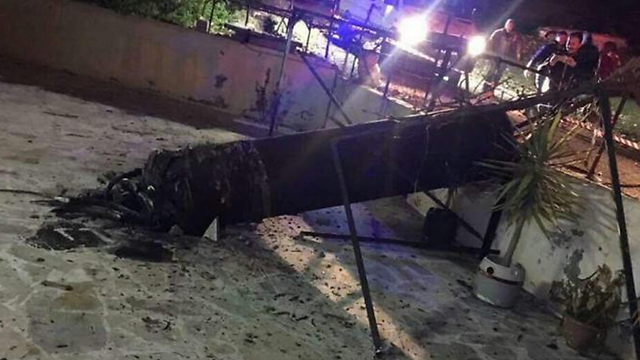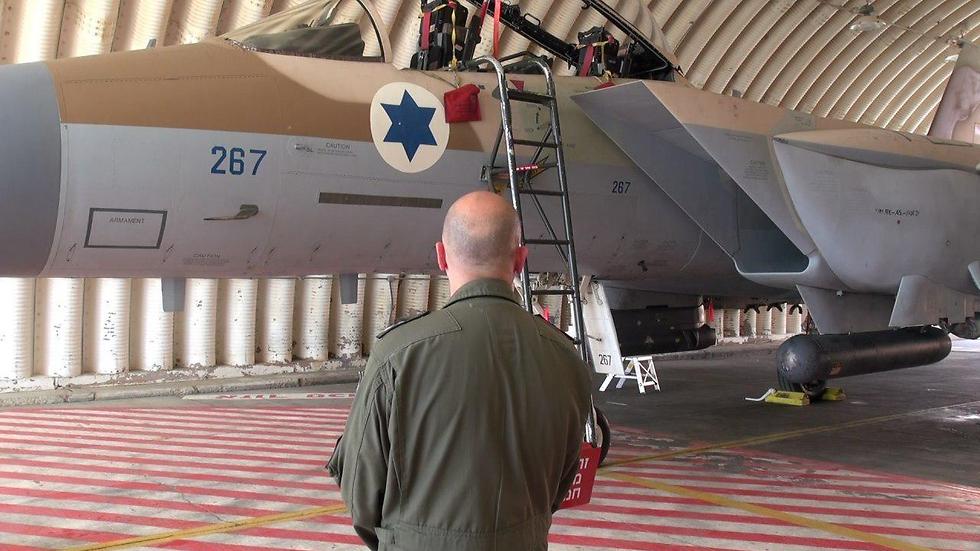
Hammers, the IAF's F-15 bombing squadron
While the IAF was welcoming new F-35 aircraft, the old tried-and-true F15I was returning from another operation against Hamas and Hezbollah; from carrying out assaults in Gaza without harming a single civilian to flying sorties over the northern skies. Here's a look at the IAF's 69th Squadron.
About two months ago, the 69 "Hammers" Squadron's F-15I Ra’am (Thunder) fighter jets returned to the Hatzerim airbase in southern Israel at 1am after a covert operation in Syria, an airstrike that targeted a shipment of advanced weapons that, according to a senior IDF officer, included around 100 missiles bound for Hezbollah.
The pilots were convinced that they would get to sleep in relative quiet and wake up in the morning to reports of "another Israeli attack in Syria"—but they soon realized their mistake.
The Syrian Army, they learned, launched outdated SA5 anti-aircraft missiles at the Israeli Air Force's (IAF) planes. The unusual—albeit failed—missile launch attested to Syrian President Bashar Assad's increased boldness. An Arrow anti-missile battery was activated to intercept the missiles, and left Israel no choice but to admit for the very first time that it attacked in Syria.
Despite the late night drama, concerns that the reveal of the operation will put a hold on the next one quickly faded, and just a few weeks passed until reports of "another Israeli attack" started to quickly spread; Israel was suspected of bombing a weapons shipment, sent via civilian transport aircrafts from Iran, in an airfield near Damascus.
The squadron was back in form, ready for the next covert operation.
It wasn't just the northern front that endured the might of the Israeli bombing squadron in its efforts to thwart attempts by terror organizations to obtain advanced weapons. The squadron, which includes dozens of F-15I fighter jets, took part in countless other such operations in Gaza, assaults on Hamas' strategic assets—including one in which 40-50 tons of explosives were dropped mid-day on Hamas combat outposts.
Despite the scale of the strike and the incredibly large amount of explosive material dropped on one of the most densely populated areas in the world, almost no Palestinians were wounded in the attack.
Hamas casualties in such an attack could very well trigger the next war. "We know what the price of a mistake is," explained Captain G., the deputy commander of the Hammers squadron.
"Everything is checked before and during (the attack). Every attack is accompanied by intelligence gathering and the 'knock-on-the-roof' practice (dropping non-explosive or low-yield devices on the roofs of targeted civilian homes as a prior warning of imminent bombing attacks to give the inhabitants time to flee), so to make sure that there are no civilians near the targets.
"Once you drop a bomb, you can't always divert it from its course or control it once it it already on its flight path, which only lasts about a minute. I see the assault's results on the cockpit screen and we record it in real time."
Another F-15 squadron?
The first F15 fighter jet, the Strike Eagle, was introduced to the IDF in 1976, but was significantly upgraded in 1988 with the introduction of the new I series (I for Israel) developed by Boeing, and named Ra'am by the IAF. These same aircrafts were the ones that, according to foreign reports, destroyed the Syrian nuclear reactor in 2007.Most of the attacks carried out by these planes are done at long range, meaning that the pilot launches the bombs dozens of kilometers away from the target—safely away from enemy radars and anti-aircraft missiles. The result: an accurate hit, despite the long distance, up to three meters off target.
Over the past year, the precision-guided munition the IAF uses, called Hail, received some unprecedented upgrades from Rafael Advanced Defense Systems. Their penetration capabilities were improved, making them able to break through reinforced concrete several meters thick, and even enter through a window at an angle to avoid harming non-combatants. The smart bombs' most substantial upgrade, though, is the increasing of their target potential—making it so that one bomb is able to hit multiple targets, located at different points on the battlefield.
"Sometimes, the volatility in the region increases, and so do combat dynamics," said squadron commander Lt. Col. G. "The instability in the region forces us to tackle threats in a highly educated and risk-averse way to avoid friction, among other things by coordinating with foreign air forces in the area."
The squadron commander detailed a few of the Ra'am's features. It can reach high altitudes of up to 40,000 feet, but its heavy munitions limit it maneuverability. In light of the recent introduction of the new F-35, and the government's decision to purchase even more F-35 aircraft, the question now is whether another F-15 squadron should be added to the IAF.
"We have to keep the diversity for the purpose of operational flexibility and be able to use the different aircraft's advantages in different battle scenarios. Looking to the future, there is no doubt that an additional Ra'am squadron will help in providing us with appropriate operational needs," said the Lt. Col.
The squadron history dates back to 1948's B-17. Throughout the years, the squadron' aircrafts were upgraded to the F-4 Phantom after the Six-Day War. "We felt like the kings of the Middle East when the Phantoms arrived," recounted IAF Brig. Gen. (res.) Yoram Agmon.
"I would have difficulties controlling all the computerized equipment that a fighter jet has these days," admitted the 78-year-old retired brigadier general. "A young pilot today would have no problem piloting the Phantom," summarized his friend, Col. (res.) Dror Ben-David. "With the Phantom, you learned (how to carry out an assault on) one target, but with the Ra'am you have tens of targets."
(Translated & edited by Lior Mor)















